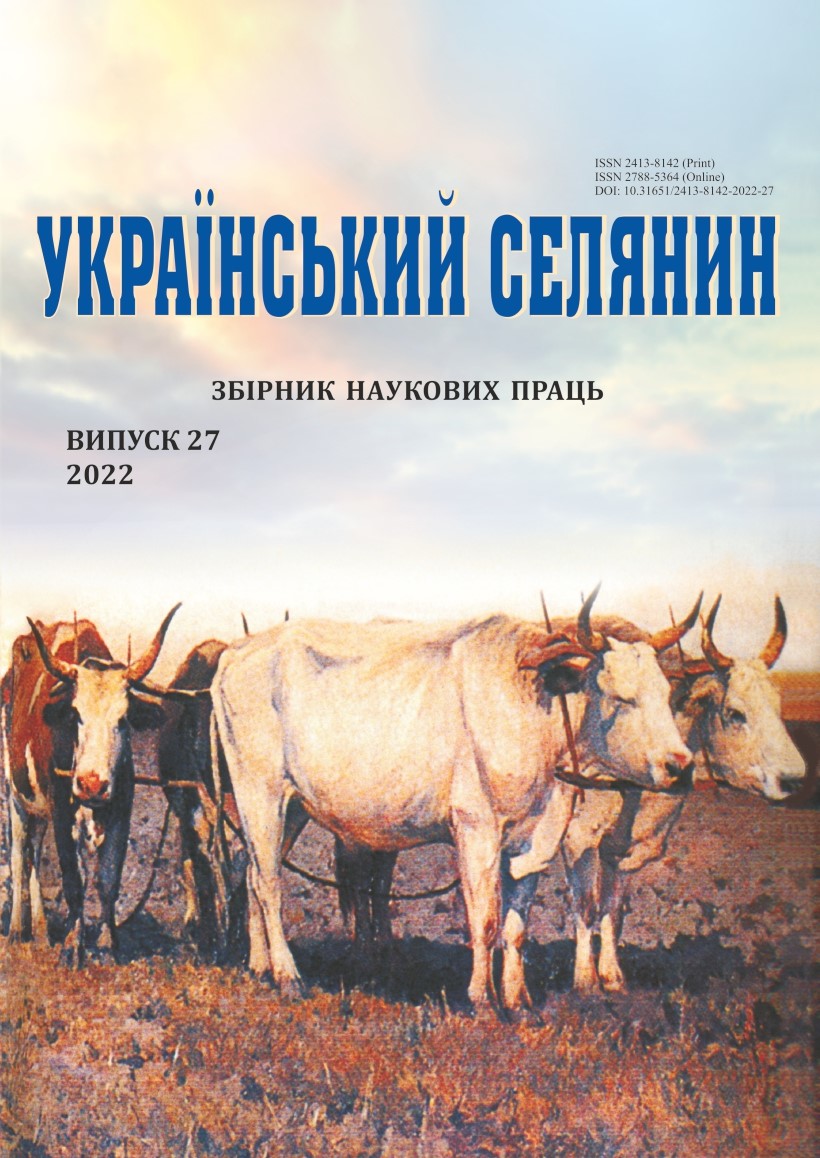Holodomor OF 1932-1933: the final of the peasant revolution
Main Article Content
Abstract
Abstract. The aim is to consider the Holodomor of 1932-1933, taking into account the events of the Рeasant revolution
of 1902-1933 in Ukraine.
The scientific novelty of the publication lies in the explanation of the Holodomor of 1932-1933 as a tool for the physical
and spiritual destruction of another for the Soviet authorities - the Ukrainian peasant-ideoman, an active subject of the peasant
revolution of 1902-1933 in Ukraine.
Conclusions. In the late 1920s and early 1930s, Soviet totalitarianism, implementing agrarian policy in the Ukrainian
countryside, forming a new type of Soviet peasant, represented a peasant counter-revolution. Its goal was clear and
understandable - not only the physical, but also the spiritual and cultural destruction of the Ukrainian peasant-ideoman,
formed at the beginning of the 20th century.
In the late 1920s – early 1930s, Soviet totalitarianism, applying taxes, grain procurement, artificially provoking the
Holodomor of 1932-1933, forming a new type of Soviet peasant, represented a peasant counter-revolution. Its goal was clear
and understandable – not only the physical, but also the spiritual and cultural destruction of the Ukrainian peasant-ideoman,
formed at the beginning of the 20th century. The Holodomor of 1932-1933 wiped out the Ukrainian peasants-ideomans, the
traditional Ukrainian peasant culture. It caused serious damage to Ukrainian identity.
Article Details
References
Bezanson, A. (1993). Viina bilshovykiv proty selian. [The war of the Bolsheviks against the peasants].
Vsesvit. [Universe], 9–10. [in Ukrainian].
Bilan, S. (2014). Sotsialno-ekonomichnyi ta natsionalno-kulturnyi zlam ukrainskoho selianstva (1929 –
rr.) [Socio-economic and national-cultural breakdown of the Ukrainian peasantry (1929-1939)] (Abstract of
doctor’s thesis.). Kyiv. [in Ukrainian].
Donik, O., Opria, B. & Fedkov, O. (2021). Politychni partii ta selianstvo v ukrainskykh huberniiakh Rosiiskoi imperii naprykintsi XIX – na pochatku XX st.: sotsiomentalni y instytutsiini chynnyky vzaiemodii. [Political
parties and the peasantry in the Ukrainian provinces of the Russian Empire at the end of the 19th and the beginning of the 20th centuries: socio-mental and institutional factors of interaction]. Ukrainskyi istorychnyi zhurnal.
[Ukrainian historical journal], 2, 42–61. DOI: https://doi.org/10.15407/uhj2021.02.029[in Ukrainian].
Farenii, I. (2014). Pro pravomirnist kontseptsii «Velykoi selianskoi revoliutsii» V.P. Danylova. [On the
legitimacy of the concept of “Great Peasant Revolution” VP Danilova]. Ukrainskyi selianyn. [Ukrainian peasant],
, 162 – 166. [in Ukrainian].
Gratsiozi, A. (2008). Velikaya krestianskaya voyna v SSSR. Bolsheviki i krestiane. 1917 – 1933. [The
Great Peasant War in the USSR. Bolsheviks and peasants. 1917 – 1933]. Moskva : ROSSPEN; Fond Pervogo
Prezidenta Rossii B. N. Eltsina. [in Russian].
Kharchenko, A. (2017). Suchasna ukrainska istoriohrafiia Holodomoru: studii ta doslidnyky. [Modern
Ukrainian historiography of the Holodomor: studies and researchers]. Istoriohrafichni doslidzhennia v Ukraini.
[Historiographic research in Ukraine], 27, 187–219. [in Ukrainian].
Konkvest, R. (2003) Rozdumy nad spliundrovanym storichchiam. [Reflections on the spoiled century].
Kyiv: Osnovy. [in Ukrainian].
Kononenko, Yu. & Kornovenko, S. (2016). Selianska revoliutsiia 1902 – ? rr. [Peasant Revolution 1902
- ?]. Ukrainskyi Selianyn. [Ukrainian peasant], 16, 73–78. [in Ukrainian].
Kornovenko, S. (2017). Selianska revoliutsiia v Ukraini pochatku KhKh st.: khronolohiia i vnutrishnia
periodyzatsiia. [Peasant revolution in Ukraine in the early twentieth century: chronology and internal periodization.]. Ukrainskyi selianyn. [Ukrainian peasant], 17, 48–56. [in Ukrainian].
Kornovenko, S. (2017). Subiektnyi skladnyk ahrarnoho pytannia yak odna z peredumov Ukrainskoi revoliutsii 1917–1921. [Subjective component of the agrarian question as one of the preconditions of the Ukrainian
revolution of 1917–1921]. Ukrainskyi istorychnyi zhurnal. [Ukrainian historical journal], 4, 83–95. [in Ukrainian].
Kovalova, N. (2016). Seliany, pomishchyky i derzhava: konflikty interesiv. «Ahrarna revoliutsiia» v
Ukraini 1902 – 1922 rr. [Peasants, landowners and the state: conflicts of interest. «Agrarian Revolution» in
Ukraine 1902 – 1922]. Dnipropetrovsk : LIRA. [in Ukrainian].
Kulchytskyi, S. (2013). Stalinska «revoliutsiia zghory». [Stalin’s “revolution from above”]. Problemy
istorii Ukrainy: fakty, sudzhennia, poshuky. [Problems of the history of Ukraine: facts, judgments, searches], 22.
[in Ukrainian].
Markova, S. (2015). Suspilni ta politychni transformatsii v ukrainskomu seli v konteksti formuvannia
totalitarnoi systemy (1917–1933 rr.). [Social and political transformations in the Ukrainian village in the context
of the formation of the totalitarian system (1917–1933)]. Kamianets-Podilskyi: Vydavets PP Zvoleiko D. H. [in
Ukrainian].
Menkouski, V., Šmigeľ, M. & Dubinka-Hushcha L. (2020) “THE HUNGER GAMES”: Ukrainian Famine of 1932–1933 in History, Historiography and Historical policy. Banská Bystrica. [in English].
Pasichna Yu. (2021). Agrarianism: a new concept of understanding the Ukrainian revolution of 1917–1921.
Ukrainskyi Selianyn. [Ukrainian peasant], 25, 79–86. DOI: https://doi.org/10.31651/2413-8142-2021-25-Pasichna [in English].
Patryliak, B. Stalin yak Putin. Holodomor – reaktsiia na milionnyi selianskyi «maidan» pochatku 1930-
kh. [Stalin as Putin. The Holodomor is a reaction to the million peasant “Maidan” of the early 1930s.]. URL: http://
www.istpravda.com.ua/ articles/ 2014/ 11/ 19 / 145925 / view_print[in Ukrainian].
Tylishchak, V. Selianski povstannia i Holodomor. Yak ukrainske selo chynylo sprotyv kolektyvizatsii.
[Peasant uprisings and the Holodomor. How a Ukrainian village resisted collectivization]. URL: https: // antikor.
com.ua/ articles/ 138356-seljansjki_povstannja[in Ukrainian].
Zakharchenko, M. (2012). Osoblyvosti sotsiokulturnoho zhyttia ukrainskoho sela u 1920–1929 rr. [Peculiarities of the socio-cultural life of the Ukrainian village in 1920–1929]. (Abstract of candidate’s thesis.).
Cherkasy. [in Ukrainian].
Кульчицький С. Сталінська «революція згори». Проблеми історії України: факти, судження, пошуки. 2013. №22. С. 111.
Харченко А. Сучасна українська історіографія Голодомору: студії та дослідники. Історіографічні
дослідження в Україні. 2017. Вип. 27. С. 187–219.

